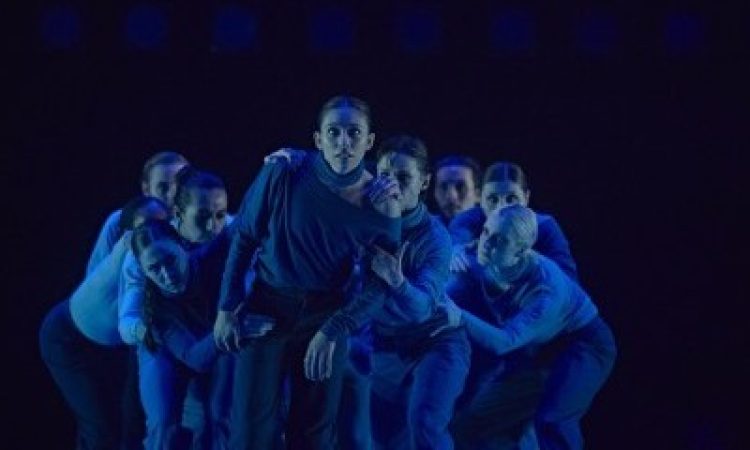Beginning with contemporary ballet, and finishing with hip-hop, the Montreal-based dance company RUBBERBAND presents Victor Quijada’s Reckless Underdog, a three-act work exhibiting a comprehensive synthesis of classical and street dance styles. Eleven dancers activate the Penn Live Arts Zellerbach Theatre, demonstrating extensive technical skill in contemporary ballet, postmodern dance, and hip-hop – presented both fusion-style, and articulated separately. Quijada’s diverse dance background serves as a foundation that seamlessly coalesces each genre in his choreography.
Reckless Underdog adopts a gender neutral approach to both costume and partnering dynamics. It’s refreshing to see androgyny embraced in the concert dance setting, which has historically valued cisgender aesthetics. As the program starts, dancers wear one-shoulder crop top uniforms with fitted spandex pants. Later, they sport oversized hoodies and cargo shorts. Their movement quality is equally ambiguous. They defy traditional partnering roles typically assigned by sex, adding a sense of cohesion, reciprocity, and interdependence to the work.
In the first act, white backdrops on three sides of the stage surround the performers. Quijada’s choreography travels like an invisible surge of energy, fostering a sense of interconnectivity between the dancers. Canons are a common occurrence in this number, further enhancing the image of an electric circuit. Paired with a classical jazz score, the movement cycles through dynamic posture shifts, gravity defying leaps, and swift lifts. The dancers’ timely and calculated responses to the music and one another vitalize the work.
As the curtains lift, their absence creates a stark contrast: darkness immerses the dancers in a void which becomes the context for act two. The ensemble’s storytelling gains an ethereal quality. Dancers stand scattered across the stage, grounded, with index fingers pointing ahead, and a distant gaze. They mark a pattern in the sky; a repeated gesture that connects the dancers even as they remain physically siloed. After several repetitions, the ensemble swarms, grasping one another in urgency, now moving as a unit. Centerstage and clumped together, the group stares out into the audience – concentrated, curious, and vigilant. A leader emerges from the group, standing in front and pushing the others back defensively as if to protect from the apparent threat that holds their gaze.
They wait.
Then, emerging from stillness, the collective gently lifts their leader off the ground, slowly sending them above and behind the group using even flow. One by one, other dancers step forward into the lead position. The ensemble lifts each leader in turn. As dancers rise into their crowd surf, their peers carry them through suspended inversions and effortless slow-motion somersaults. The dancers convey a sense of ease in this repetitious, trance-like sequence, disguising the rigor and focus of the exercise. The cycle is sustained, meditative, almost therapeutic to watch. I imagine the stunt itself requires a similar mindfulness and somatic attention to accomplish.
In the closing act, the ensemble takes on physically demanding, highly kinesthetic choreography that exhibits strength, stamina, and hip-hop vocabulary. With evident influences from Quijada’s breaking background, the company performs a series of synchronized floorwork, headstands, baby freezes, and swipes that are enmeshed with the malleable flow of their contemporary repertoire. The choreography samples hip-hop fundamentals like bounces, stops, and waves as the piece builds to replicate a cypher. While the high intensity movement shows the dancers’ athleticism, precision, and ability to embody the movement repertoire of hip-hop, the essence of the dance is formulaic. I was hungry for more individuality and freestyle – more expression, personality, and exchange. Though well-rehearsed (an accolade in most dance contexts) the dance was so highly choreographed that, for me, it missed the mark on this staple of hip-hop, making this section feel more like an impersonation than an authentic demonstration of the culture. In bringing street dance to the concert stage, we meet the intersection of performance and social dance. However, in this work, the social aspect is commercialized. The freestyle, storytelling, and social exchange of breaking and hip-hop are prescribed in the choreography and reduced to the abstract, so that the performance aspect becomes the nucleus.
RUBBERBAND brings a uniquely versatile and interdependent performance to the theater. The impressive collection of movement composition utilizes the company’s volume and talent to the max in a way that pushes boundaries and challenges social norms. The aesthetic aspects of breaking and contemporary permeate one another on stage and make for a powerful showcase while still excluding much of the essence of breaking culture. I wonder how much the premiere of breaking as an official Olympic sport has and will influence the acceptance of the form’s commodification. How might breaking’s history of resistance, interpersonal presence, originality, and authentic catharsis be preserved and retold with homage?
Reckless Underdog, RUBBERBAND, Penn Live Arts, February 15-16.






